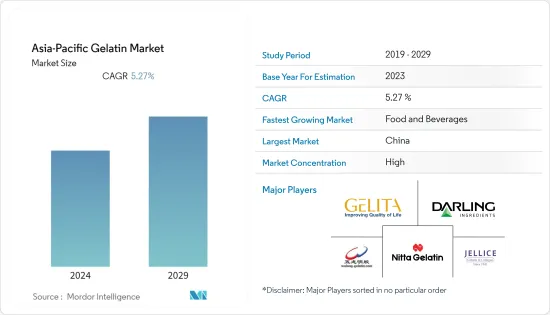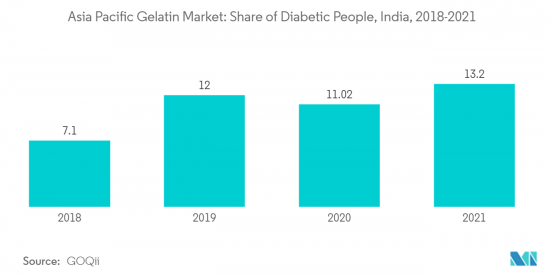PUBLISHER: Mordor Intelligence | PRODUCT CODE: 1406957

PUBLISHER: Mordor Intelligence | PRODUCT CODE: 1406957
Asia-Pacific Gelatin - Market Share Analysis, Industry Trends & Statistics, Growth Forecasts 2024 - 2029

The Asia-Pacific gelatin market is expected to grow from USD 697.31 million in 2024 at a CAGR of 5.27% over the next five years.
Key Highlights
- Gelatin has a unique amino acid arrangement in its sequence and contains a relatively high amount of glycine, proline, and alanine. Gelatin's bioactivities stem from the fact that its primary structure contains biologically active peptide sequences. The most common types of gelatin are manufactured from porcine skin and bovine bone and hide. It has unique characteristics that make it specifically useful as a gelling agent, binder, emulsifier, and thickener.
- Gelatin is additionally used in the pharmaceutical sector to create capsules, pills, wound dressings, and hemostats. Gelatin is another ingredient found in a number of cosmetics, including shampoos, conditioners, and lotions for the skin. The demand for items made using gelatin is anticipated to rise as these sectors expand in the Asia Pacific region.
- Moreover, the increasing awareness about the benefits associated with gelatin has drawn manufacturers to invest in scientific research and conduct intensive pre-clinical and clinical research to examine the connection between nutrition and bone health. Based on this research, innovative gelatin products to increase bone density are being developed to cater to the rising demands of consumers.
- The safety and quality of food products containing gelatin are ensured by government agencies in many countries in the Asia Pacific area through restricted standards and regulations. Manufacturers are frequently required by these laws to utilize only permitted substances and to adhere to particular production procedures. For instance, the State Food and Drug Administration (SFDA) of the Chinese government mandates that all gelatin used in food items come from the skin or bones of bovine or porcine animals and undergo stringent processing and sterilization methods to assure food safety.
Asia-Pacific Gelatin Market Trends
Increasing Demand for Low-Fat and Fat-Free Food Products
- Owing to the increasing health consciousness for obesity, diabetes, and other health-related diseases, consumers are shifting toward low-calorie, fat-free food products. According to the Japan Ice Cream Association, ice cream was the most popular dessert in Japan, with over 28% restricting themselves to once a week. Close to 8% of respondents enjoyed the cold treat almost daily. Gelatin plays a vital role in the preparation of low-fat or reduced-fat meals. Due to its ability to form an oil-in-water emulsion, it can be used partially to replace the high-fat content in many products. Without gelatin, it is hard to develop many low-fat products, such as half-fat margarine, reduced-fat cheeses, or yogurt variations. Products, such as half-fat butter, reduced-fat cheese, and fat-free ice cream gelatin, help minimize the fat content without compromising taste.
- In pizza cheese, for example, gelatin not only reduces the fat content but also improves the melting properties. Gelatin improves stability, increases shelf life, and gives the product a creamy texture. By considering its binding properties, gelatin increases the yield of cheese production and allows for cost-saving. Low doses of gelatin (0.2 to 3%) are sufficient to give dairy products the required texture.
- Moreover, gelatin facilitates aeration, stabilizes the ice cream, improves low-temperature conservation, and prevents the formation of ice crystals during long-term conservation. It also improves ice cream's resistance to temperature variations. Combined with other texturing agents, it gives the ice cream a very characteristic texture and slows the melting of the ice cream in the mouth. Gelatin also creates a fat-like matrix in emulsions that exhibit shear-thinning properties and fat-like creaminess. Thus, the addition of gelatin results in a smooth, creamy texture and a compatible appearance and taste. In addition, gelatin is used to create sliceable aspics, sausages, and spreadable products in meat products, which have significantly fewer calories than other meat or sausage products. Spreadable sausages have a higher fat content, but gelatin provides excellent texture and improved spreadability while reducing the fat and calorie content. Thus, the increasing demand for low-fat, fat-free food products is, in turn, creating a potential market for food-grade gelatin, as it is widely used as an ideal fat replacement without causing any changes in the texture or taste or having any side effects.

China Held the Largest Market Share
- The growth of the gelatin market in China has been significantly fueled by the rising demand for gelatin across a range of end-use industries. In the food and beverage industry, gelatin is a commonly used component. It is used as a gelling agent, stabilizer, and thickening in a variety of goods, including confectionery, dairy, desserts, and beverages.
- Gelatin is additionally used in the pharmaceutical industry to create capsules, pills, wound dressings, and hemostats. Gelatin is another ingredient found in a number of cosmetics, including shampoos, conditioners, and lotions for the skin. The gelatin market has expanded as a result of China's expanding population.
- China has the largest population in the world, with approximately 1.4 billion people. The demand for foods, medications, and other consumer goods containing gelatin is rising along with the population. Gelatin demand in the nation is predicted to increase as a result of this trend.
- Moreover, the gelatin market has expanded as a result of China's expanding disposable income. For instance, according to the National Bureau of Statistics of China, the per capita disposable income of households in China was 36,883 yuan in 2022. Consumers are increasingly eager to spend money on high-quality, safe, healthy, and secure food products, medications, and cosmetics when earnings rise. The demand for gelatin-based goods that are seen as high-quality and safe has surged as a result, such as collagen supplements, which are said to have anti-aging and skin-improving effects.
- The Chinese government has also put in place regulations that are intended to increase the quality and safety of food and medicinal items. As an illustration, the government has put out laws mandating that manufacturers adhere to rigid safety and quality standards. Due to consumers' growing willingness to pay a premium for goods that are regarded as safe and of high quality, this has raised the demand for gelatin made in accordance with these regulations.
Asia-Pacific Gelatin Industry Overview
The Asia Pacific gelatin market is highly competitive, with both regional and global players present. The growing popularity of gelatin-based products across various applications is expected to boost the market for gelatin in the global market. The key players in the market include Darling Ingredients Inc., GELITA AG, Jellice Group, Luohe Wulong Gelatin Co. Ltd., and Nitta Gelatin Inc. The key players have a wide geographical reach, and the products manufactured by them are increasingly being used in various applications, including food and beverage, confectionery, dietary supplements, and other industries.
Additional Benefits:
- The market estimate (ME) sheet in Excel format
- 3 months of analyst support
TABLE OF CONTENTS
1 INTRODUCTION
- 1.1 Study Assumptions and Matrket Definition
- 1.2 Scope of the Study
2 RESEARCH METHODOLOGY
3 EXECUTIVE SUMMARY
4 MARKET DYNAMICS
- 4.1 Drivers
- 4.1.1 Increasing Demand for Low-Fat and Fat-Free Food Products
- 4.1.2 Expanding Cosmetic and Personal Care Industries Utilize Gelatin for Various Purposes
- 4.2 Restraints
- 4.2.1 Fluctuations in Raw Material Proces Affecting Production Costs
- 4.3 Porter's Five Forces Analysis
- 4.3.1 Threat of New Entrants
- 4.3.2 Bargaining Power of Buyers/Consumers
- 4.3.3 Bargaining Power of Suppliers
- 4.3.4 Threat of Substitute Products
- 4.3.5 Intensity of Competitive Rivalry
5 MARKET SEGMENTATION
- 5.1 Form
- 5.1.1 Animal Based
- 5.1.2 Marine Based
- 5.2 End -ser
- 5.2.1 Personal Care and Cosmetics
- 5.2.2 Food and Beverage
- 5.2.2.1 Bakery
- 5.2.2.2 Confectionery
- 5.2.2.3 Condiments/Sauces
- 5.2.2.4 Beverages
- 5.2.2.5 Dairy and Dairy Alternative Products
- 5.2.2.6 Snacks
- 5.2.2.7 RTE/RTC Food Products
- 5.3 Geography
- 5.3.1 Asia Pacific
- 5.3.1.1 China
- 5.3.1.2 India
- 5.3.1.3 Australia
- 5.3.1.4 Japan
- 5.3.1.5 Rest of Asia Pacific
- 5.3.1 Asia Pacific
6 COMPETITIVE LANDSCAPE
- 6.1 Strategies Adopted by key players
- 6.2 Market share analysis
- 6.3 Company Profiles
- 6.3.1 Asahi Gelatine Industrial Co. Ltd
- 6.3.2 Darling Ingredients Inc.
- 6.3.3 Foodchem International Corporation
- 6.3.4 GELITA AG
- 6.3.5 Italgelatine SpA
- 6.3.6 Jellice Group
- 6.3.7 Luohe Wulong Gelatin Co. Ltd
- 6.3.8 Nitta Gelatin Inc.
- 6.3.9 India Gelatine & Chemicals Ltd
- 6.3.10 Narmada Gelatines Limited
- 6.3.11 Xiamen Hyfine Gelatin Co. Ltd
7 MARKET OPPORTUNITIES AND FUTURE TRENDS




